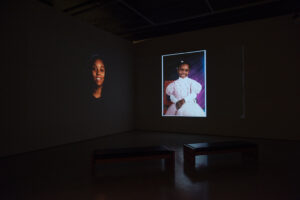The Group of Seven was founded in 1920 as an organization of self-proclaimed modern artists. The original members — Franklin Carmichael, Lawren Harris, A.Y. Jackson, Franz Johnston, Arthur Lismer, J.E.H. MacDonald and F.H. Varley — befriended each other in Toronto between 1911 and 1913. All except Harris, who was independently wealthy, made their living as commercial artists, and several of them even worked together in the same shop. Tom Thomson, another commercial artist, was included in this circle of friends, but since he died in 1917 he never became a member of the Group. He was important to the other artists, however, for he was an avid outdoorsman and awakened their interest in painting the rugged northern Ontario landscape.
The Group was not exclusively landscape painters, and it was only after their first exhibition at the Art Gallery of Toronto in 1920 that they began to identify themselves as a landscape school. They were initially drawn together by a common sense of frustration with the conservative and imitative quality of most Canadian art. Romantic, with mystical leanings, the Group and their spokesmen zealously, and sometimes contentiously, presented themselves as Canada’s national school of painters. This provoked the ire of the artistic establishment, which seems to have hated their rhetoric even more than their paintings. Eric Brown, director of the National Gallery of Canada, always stood by them. He began buying their paintings for the gallery’s collection several years before the Group was formally established, and in 1924 and 1925 he made sure they were well represented in the Canadian art shows that went to the prestigious Wembley exhibition in England. This enraged many members of the Royal Canadian Academy, who felt that the Group was given an unfair advantage, but British press reports were so favourable that both Brown and the Group felt vindicated.
Like the European fin de siècle symbolists and post-impressionists from whom their aesthetic largely derived, the Group rebelled against the constraints of 19th-century naturalism and tried to establish a more equitable and independent relationship between art and nature. They shifted emphasis away from similitude — the imitation of natural effects — towards the expression of their feelings for their subjects. As they often painted together, both in the bush and in the studio, their paintings developed along somewhat similar lines. The canvases exhibited in their early shows usually have heavy impasto and bright colours, and are boldly summarized with attention drawn to surface patterning. This is as true of the portraits of Harris and Varley as of the landscapes. Following a visit to the stark north shore of Lake Superior in 1921, Harris began to radically simplify the colour and layouts of his canvases. MacDonald, Carmichael and even Varley soon adopted similar methods, using thin pigment and stylized designs for many paintings. Harris went further than the others, however, and by the mid-1920s he had reduced his paintings to a few simplified and nearly monochromatic forms. Ten years later he became the only member of the Group, and one of the first Canadian artists, to turn to abstraction.
Through self-promotion and through friends at the Arts and Letters Club and the Canadian Forum, as well as with the support of the National Gallery, the Group’s influence steadily spread during the 1920s. In 1926, after Franz Johnston’s resignation, A.J. Casson was appointed a member. The Group realized they could hardly call themselves a national school of painters as long as they all lived in Toronto, so they invited other artists to join them: in 1930 Edwin Holgate from Montréal and in 1932 L.L. Fitzgerald from Winnipeg were admitted to give the organization a wider geographic base.
Harris and Jackson influenced and encouraged the next generation of Canadian artists, and Lismer, MacDonald and Varley all became distinguished and influential teachers. By the time the group disbanded in 1933, however, it had become as entrenched, and in some ways as conservative, as the art establishment it had overthrown. Its influence has therefore been a mixed blessing, and it is not surprising that it was in Montréal, which did not respond to the Group’s call, that the next generation of significant Canadian painters emerged. Paintings by members of the Group of Seven can be found in most Canadian public art galleries.
Supported by





